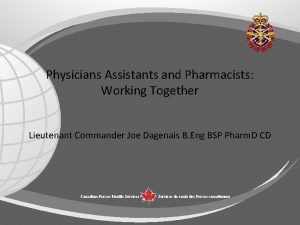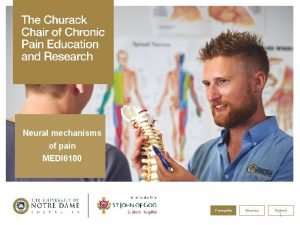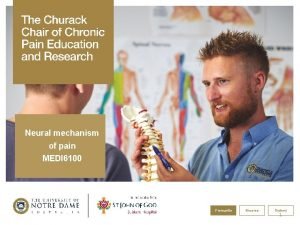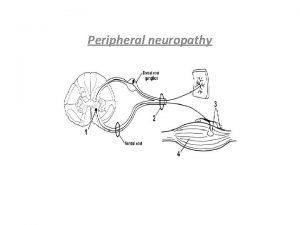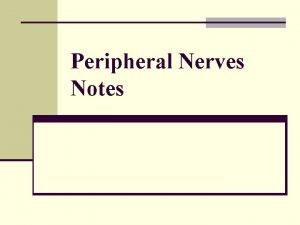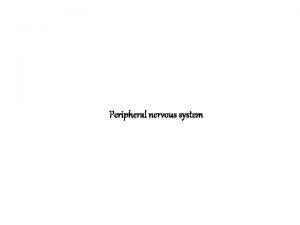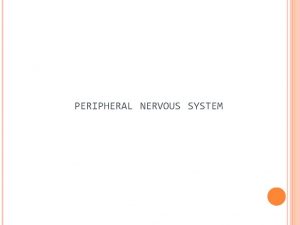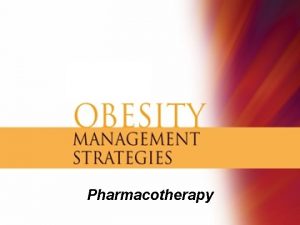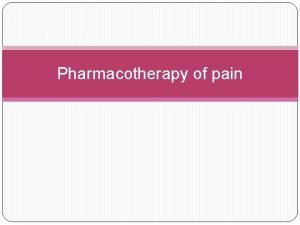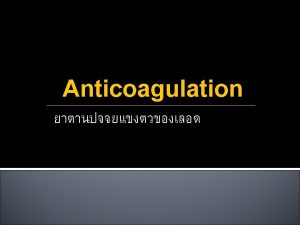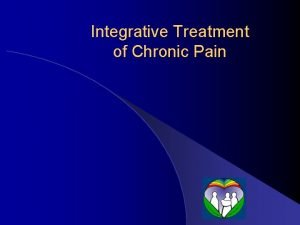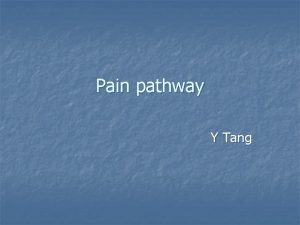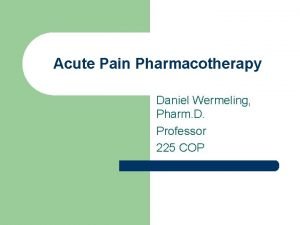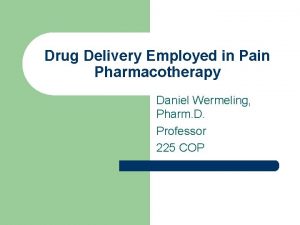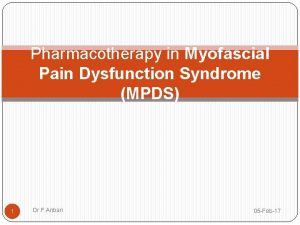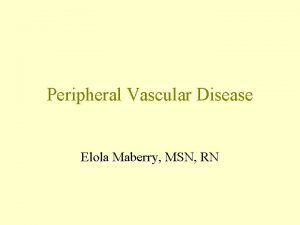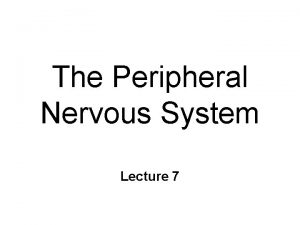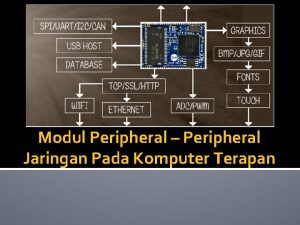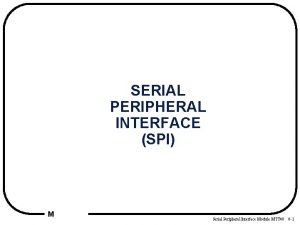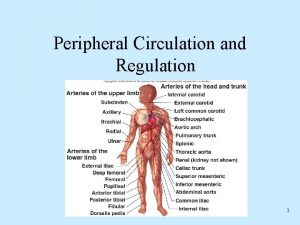Pharmacotherapy of Pain The Pain Pathway 1 Peripheral


























- Slides: 26

Pharmacotherapy of Pain

The Pain Pathway 1. ) Peripheral nociceptors • bradykinin, substance P, histamine, acetylcholine, serotonin, ↓ p. H (H+), prostaglandins (inflammatory mediators) 2. ) Primary afferent fibres → dorsal horn of spinal cord • substance P, neurokinin A, glutamate • Inhibition of pain transmission on spinal level = descending pathways from midbrain and medulla to dorsal horn (serotonine, noradrenaline, GABA enkefalins…) 3. ) Spinothalamic and spinorecticular tract (spine → thalamus/brainstem reticular formation) • Localisation a emotional aspects of pain 4. ) Thalamocortical pathway (thalamus → cortex) • Localisation, cause of pain + coordination of a response

NSAIDs • Non-steroidal antiinflammatory drugs • Inhibition of cyclooxygenase = ↓ prostaglandins • Treatment of „common“ pain, inflammatory diseases (gout, rheumatoid arthritis etc. ), reduction of fever, combination of analgesics in stronger pain • Administration – p. o. , rectal, topical, parenteral • Binding to plasma proteins – possible interactions • Good GIT absorption, passage into the synovial fluid, fluid through BBB, placenta… Classification: 1. ) NON-SELECTIVE (COX 1 ~ COX 2) 2. ) PREFERENTIAL (COX 1 < COX 2) 3. ) SELECTIVE (COX 1 <<< COX 2)

Cyclooxygenase • Isoenzymes: physiological, inducible, (CNS? ) • COX 1 – protection of gastric mucosa, kidney vasodilation, aggregation of thrombocytes • COX 2 – site of inflammation, expressed due to ILs and TNF -α • COX 3 – CNS?

Essential FA + NOXIOUS STIMULI – LIPOCORTIN (ANNEXIN) Phospholipids NSAIDs – COX Cyclic endoperoxides PROSTAGLANDINS pain, inflammation, ↓ HCl, ↑ gastric mucus, uterus contractions, ↑ kidney perfusion, ↑ excretion of Na+ and water Phospholipase A 2 Arachidonic acid PROSTACYCLIN vasodilation, inhibition of thrombocytes aggregation Glucocorticoids LOX LEUKOTRIENS TROMBOXANS allergy, vasoconstriction, leucotaxis ↑ thrombocytes aggregation

Acetylsalicylic acid • non-selective, irreversible COX inhibitor • plasmatic esterases: ASA → SA + AA • 30 -100 mg antiaggregant, antiaggregant 500 mg analgesicantipyretic, antipyretic over 1000 mg antiphlogistic gastric absorption, possible irritation and ulceration of GIT (Mo. A + acidity), renal excretion • • contraindications: children up to 12 years old – Reye‘s syndrome gastric ulcers, asthma before surgery • • elderly – more susceptible to AE „aspirin asthma“ = leucotriens predominance • other salicylates: choline salicylate, sulfasalazine…

Paracetamol (Acetaminophen) • analgesic-antipyretic = without antiphlogistic and antiaggregant activity, no gastrotoxicity • mechanism of action unclear: • COX 3? serotonin? TRPV ion channels? • dose: 10 -15 mg/kg – frequently underdosed! • max. dose 4000 mg (8 tablets à 500 mg) • hepatotoxicity = NAPQI, detoxification by glutathione • overdosing – N-acetylcysteine therapy • combinations with tramadol, codein, propyphenazone, antispasmodics • suitable for children, elderly

Acetic Acid Derivatives Diclophenac ‒ joint diseases → passage into synovial fluid ‒ shorter half-life, capsules with prolonged release ‒ cardiotoxicity – higher doses, contraindication Aceclofenac ‒ oral use only in the treatment of joint diseases ‒ relatively low gastrotoxicity ‒ also contraindicated for patients with CVD Indomethacin ‒ strong effect, only for short-term treatment ‒ uricosuric effect = ↑ excretion of uric acid in the urine ‒ used in acute gout attack ‒ ↑ gastrotoxicity, gastrotoxicity changes in blood count, headache and CNS disorders (all of them very frequent) ‒ contraindicated for children

Propionic Acid Derivatives Ibuprofen – good tolerability, safe ‒ 200 -400 mg analgesic, antipyretic ‒ 1400 -1600 mg antiphlogistic ‒ max. dose 2400 mg ‒ suitable for children Ketoprofen – topical use (skin phototoxicity!) Dexketoprofen – oral use Flurbiprofen – topical oral use (lozenges/pastilles) Naproxen – relatively low gastrotoxicity, longer half-life, good for headache and toothache

Other Important Analgesics Propyphenazone – with paracetamol and caffeine Metamizole • analgesic-antipyretic with mild antispasmodic effect • no antiphlogistic effect • myelotoxicity (changes in BC) → only for short-term use • combinations with antispasmodics (e. g. pitofenone, fenpiverinium) Oxicams – long biological half-life: • Piroxicam – topical use, very long half-life (high risk of accumulation if taken orally) • Meloxicam – preferential effect on COX 2 • joint diseases – good passage into synovial fluid • reduction of GIT adverse effects • Lornoxicam – non-selective effect on COX

Preferential COX 2 Inhibitors • • COX 1 < COX 2 reduction of GIT adverse effects • analgesic, antiphlogistic and antiaggregant effect Nimesulide • inhibits also collagenases and elastases degrading cartilages + ROS scavenger • hepatotoxicity → only for short-term use (15 days) Meloxicam

Selective COX 2 Inhibitors = Coxibs • COX 1 <<< COX 2 • minimal GIT adverse effects • joint diseases • cardiovascular AE – thrombotic diseases (due to inhibition of prostacyclin in endothelia) • contraindicated for patients with CVD • some of them withdrawn and lost market authorisation for severe CV and skin AE (rofecoxib) • celecoxib, parecoxib, etoricoxib

Protection against NSAIDs toxicity • use of safe dosage • fight against overuse, misuse „dependence“ • protection of gastric and intestinal mucosa (PPI – omeprazole) • education of both patients and health professionals • avoidance of drug-drug interactions

Opioid analgesics

Opiod analgesics = anodynes OPIUM – Papaver somniferum, Papaveraceae Bind to opiod receptors – changes in ion homeostasis of neurons → hyperpolarization, hyperpolarization inability to conduct electrical impulses + changes in GABA signalling in specific parts of the brain OPIOID RECEPTORS: μ [mu] – supraspinal and spinal analgesia κ [kappa] – spinal and peripheral analgesia δ [delta] – spinal analgesia σ [sigma] – dysphoria, hallucinations, changes in perception (not an opioid receptor, bud some opioids have affinity for it)

Classification of Opioids According to their receptor effects: 1. ) Agonists: a) strong effect (morphine, pethidine, methadone, fentanyl) b) medium and mild effect (codeine, dextropropoxyphene) 2. ) Partial agonists (buprenorphine) and agonists-antagonists (butorphanol) 3. ) Atypical opioids (tramadol, tilidine, tapentadol) 4. ) Antagonists (naloxone, naltrexone) According to their origin: a) endogenous (enkephalins, endorphins, dynorphins) b) natural (morphine, codeine…) c) semisynthetic (oxycodon, dihydrocodeine…) d) synthetic (pethidine, butorphanol, methadone, fentanyl. . . )

Opioid Agonists: Effects • mostly originate from activation of μ receptors Central effects: • depression of CNS: sedation → somnolence → coma • depression of breathing – ↓ sensitivity of respiratory center • antitussive effect – ↓ sensitivity of cough center • emesis, nausea – first doses, irritation of area postrema • miosis – via n. oculomotorius • changes in hormonal levels: levels cortisol, ADH, Gn. RH → FSH, LH, testosteron…) Peripheral effects: • ↑ smooth muscle tone – constipation, urine retention, spasm of sphincters in GIT and GUT (contraindicated for colics!) • CVS – histamine liberation, vazodilation, postural hypotension • RESP – possible bronchoconstriction (histamine)

Opioid Agonists Pharmacokinetics: • good absorption from GIT, but frequently high first pass effect (= not suitable for oral use) • pharmacologically active metabolites (e. g. codeine) Addictive potential • dependency producing substances • tolerance – need for higher doses • craving for another dose • abstinence syndrome • Act No. 167/1998 Coll. on Dependency Producing Substances • instructions for prescription and use • methadone – substitution therapy for the addicted

Opioid Agonists with Strong Effect • MORPHINE – 10 mg i. m. , s. c. , p. o. , lasts 4 -5 h • METHADONE – longer half-life, substitution therapy • OXYCODON, HYDROCODON • with paracetamol (acetaminophen) • PETHIDINE Fentanils • the most effective opioids • lipophilic → good absorption • shorter effect → infusions, TTS • anesthesiology, algesiology • FENTANYL or FENTANIL • SUFENTANIL – 500 times more effective than morphine

Opioid Agonists with Medium and Mild Effect CODEINE • metabolised to morphine DIHYDROCODEINE • cancer pain • analgesic – combined therapy (paracetamol) • • antitussive: antitussive 10 -30 mg • decreases secretion in bronchi and bronchioles • contraindicated for children tablets with prolonged release

Partial agonists and Agonists-Antagonists BUPRENORPHINE • ↓ AE, ↓ dependency • mild analgesic effect • partial agonist of μ opioid receptors • strong FP effect – parenteral BUTORPHANOL administration (buccal tablets) • RMP Suboxone – combination therapy with naloxone (opioid addiction) PENTAZOCINE • κ a δ agonist • μ antagonist • mild analgesic effect • σ and κ activation = hallucinations, euforia, dysforia, abnormal dreams

Atypical Opioids TRAMADOL • low affinity for μ receptors + blockade of 5 -HT and NA re-uptake (neurotransmitters of pain pathway) • • max. dose 600 mg frequently causes nausea and emesis oral drops, tablets, modified release advantages: no attenuation of respiratory center no constipation TILIDIN, TAPENTADOL

Opioid Antagonists • • • treatment of acute opioid intoxication and overdosing treatment of addiction to opioids, opioids heroin treatment of alcohol addiction (nalmefene) quick effect (in minutes), lasts 2 -3 h parenteral use, oral use (nalmefene) NALOXONE NALTREXONE NALMEFENE

Strategy in the Treatment of Pain WHO PAIN LADDER 1. CAUSAL TREATMENT • cause of pain 2. SYMPTOMATIC TREATMENT • pain itself

Anti-rheumatics – Therapy of RA DMARDs – disease-modifying antirheumatic drugs • SULFASALAZINE ‒ bowel microflora decomposition → 5 -aminosalicylic acid and sulfapyridine • GOLD COMPOUNDS ‒ e. g. sodium aurothiomalate ‒ inhibition of phagocytosis • CHOLOROQUIN ‒ originally for treatment and prevention of malaria ‒ inhibition of chemotaxis of leukocytes • METHOTREXATE ‒ immunosupressive therapy ‒ folic acid antimetabolite ‒ used in high dosis as cytostatic drug (cancer therapy) ‒ highly effective ‒ effect starts after 3 -4 weeks

Anti-rheumatics Targeted therapy: • Targeted interference with immune cells and mediators • Monoclonal antibodies, genetically engineered proteins… • Expensive, prescribed only when conventional treatment fails • Mechanisms of action: • anti-TNF-α drugs: ADALIMUMAB, ADALIMUMAB infliximab, etanercept, certolizumab, golimumab • blockade of IL-6 receptor: tocilizumab • blockade of IL-1 receptor: anakinra • interference with T and B lymphocytes: abatacept, rituximab NSAIDs: • Alleviation of morning joint stiffness • Analgesic and antiinflammatory effect • DICLOFENAC, IBUPROFEN; MELOXICAM, CELECOXIB and the others…
 Pharmacotherapy workup
Pharmacotherapy workup Pharmacotherapy
Pharmacotherapy Pharmacotherapy
Pharmacotherapy Intensivis
Intensivis Pain pathway diagram
Pain pathway diagram Nociceptive pain
Nociceptive pain Martian pain
Martian pain Pms or pregnancy
Pms or pregnancy Pms vs pregnancy
Pms vs pregnancy Mật thư tọa độ 5x5
Mật thư tọa độ 5x5 Tư thế ngồi viết
Tư thế ngồi viết ưu thế lai là gì
ưu thế lai là gì Voi kéo gỗ như thế nào
Voi kéo gỗ như thế nào Thẻ vin
Thẻ vin Thể thơ truyền thống
Thể thơ truyền thống Các châu lục và đại dương trên thế giới
Các châu lục và đại dương trên thế giới Từ ngữ thể hiện lòng nhân hậu
Từ ngữ thể hiện lòng nhân hậu Diễn thế sinh thái là
Diễn thế sinh thái là Vẽ hình chiếu vuông góc của vật thể sau
Vẽ hình chiếu vuông góc của vật thể sau Frameset trong html5
Frameset trong html5 V cc
V cc Phép trừ bù
Phép trừ bù Hát lên người ơi alleluia
Hát lên người ơi alleluia Lời thề hippocrates
Lời thề hippocrates Hổ sinh sản vào mùa nào
Hổ sinh sản vào mùa nào Tư thế worm breton là gì
Tư thế worm breton là gì đại từ thay thế
đại từ thay thế
